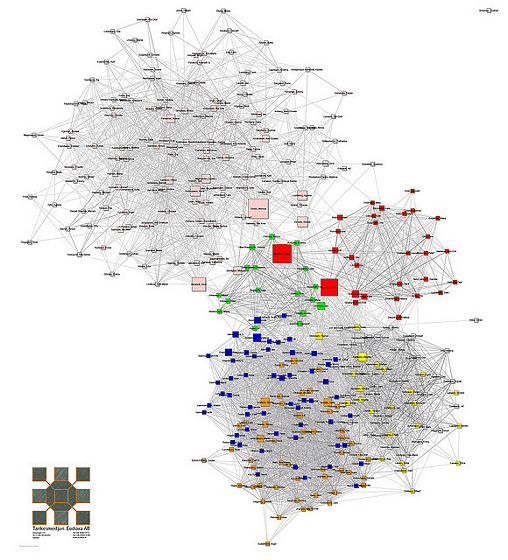How is the algorithm for generating Facebook news feeds decided?

ByChris Potter
On Facebook's home screen, people related to you and posts of accounts that follow are displayed in the timeline. It is said that 1 billion people are using Facebook worldwide on a daily basis, and the contents of algorithms deciding Facebook timeline are said to be top secret, but at the development site Then it seems that a muddy work that seems surprising is done.
Online Magazine'sSlateSaid he got the opportunity to enter the site of a news feed development team located in Facebook's head office located in Menlo Park, California. Here, the state of Facebook's algorithm development seen by a reporter is introduced.
How Facebook's news feed algorithm works.
http://www.slate.com/articles/technology/cover_story/2016/01/how_facebook_s_news_feed_algorithm_works.single.html
Slate expresses that Facebook's algorithm is not surprisingly sophisticated, fickle and totally opaque. Certainly Facebook is sometimes made to look at information that is insignificant to the user, whatever it is, and there are few Facebook users who agree to the expression of Slate. The Facebook algorithm gathers all the posts of the people connected by the user and decides what to display based on its own evaluation.
It seems that Facebook is keeping track of this, he said that he repeated the test of mixing the top feed of each user and posts of the lower feed over the course of several months. As a result, we announced that the algorithms and user's orientation were "occasionally" consistent, but the concrete results have not been clarified. For Facebook this kind of divergence will be expressed as "room for improvement".
Creating an Algorithm Slate's reporter who got the opportunity to infiltrate the site tells how its inside and algorithm are made.
Reporters who visited Facebook's headquarters in Menlo Park, California, caught a glimpse of the mechanism by which Facebook news feeds are generated, and witnessed the limit. It is said that there was a pitfall of decisions made by data and the way to make improvements based on "feedback" from real users.

What I was doing there was that it was a job by a human who tried to improve the algorithm. Faults in Facebook algorithms are not surprising due to 'system inadequacy' which is often thought out, and it is surprising that most of them are caused by human who made it. When something goes wrong, professional staff gathers with the data, gathers the conference, conducts the test, and carries out the remedial measures repeatedly.
The algorithm used by Facebook is never a single one, and as a result of combining several algorithms in a complex manner, something like one master algorithm has been completed. Its basis is specific to each userRelevance Score(Relevancy score) based on the judgment. Therefore, the content is totally different from person to person.
What Facebook uses here is called "prediction algorithm", and the system has adopted a mechanism of sorting posts on a certain standard and picking up and displaying what would fit the user's orientation Thing. At the same time, items such as whether the user actually clicks, comment on, share it, whether to display it in reverse, whether to report as spam, etc. are predicted at the same time. Then, it seems that it is a mechanism that the prediction algorithm is corrected depending on the actual page to be displayed to the user and what kind of behavior it took action.
In this way, an algorithm is created based on "feedback" by human's actual behavior, but here one problem lies. That is the fact that humans do not always take correct action. Evaluation and behavior change with the mood at that time, and in addition, it is not unusual to take actions that are different from original because of mistakes in operation. There is a difficulty that humans are too complex to model as "algorithms".

ByAnders Sandberg
Facebook, which started as an SNS for students in 2004, was opened to the public in 2006 and began gradually increasing the number of users. At that time, Facebook was a simple service that only lists the information of each user's profile page and group, but in 2006 it added a timeline as a function of a hub to display a list of updates and actions made by friends It was done. This is the prototype of the timeline leading to the present, but at the beginning there were many negative opinions that the update contents were displayed one by one or boring contents were displayed one after another on their own page. But Facebook pushed the use of the timeline.
It is becoming increasingly important to find out what is truly important from the impressing timeline display, but it is not easy to decide what really matters really. There was no "Like" button on Facebook at that time, so it is not an exaggeration to say that the difficulty was higher than it is now. The team of engineers at Facebook has started developing a primitive algorithm based on intuition to cope with the problem. In the early algorithm development, it seems that what was used as a criterion parameter was "how much recent posting" and "how much do you mention about friends?"
After that, the engineer team continued the adjustment of the algorithm, continued work to evaluate by watching how the stay time of the user changes every time improvement is made. However, since there is no way to essentially grasp the actual state of whether such postings actually please the user, whether it makes it uninteresting, aggressive or confusing, basically the engineer "throws darts It seems that we made adjustments at intervals.
After that, the "Like" button is now implemented, but this function is not just a new action that the user can do on the site. For Facebook, it is meaningful as one of the ways to surely grasp what kind of reaction the user actually showed. Users who knew the purpose of the real "Like" button at this point should have been quite limited. In this way, Facebook says the process of secretly measuring the user's orientation and reflecting it in the algorithm.

ByCharis Tsevis
Next, the era of "viral" comes to Facebook. A method for gathering as many "good likes" as possible is developed, and a specialized consultant can use techniques such as "how to use the correct term", "time zone to post", "the correct combination of words and photos" You click on a good news! "And so on and devise a kind of" battle "to Facebook's algorithm. As a result, Facebook's timeline has come to be filled with viral media.
It appeared here that "engagementThat is the element. Actual nice! There is a limit to measuring importance based on number, number of comments, number of shares. For example, if the content of the submission is sad content and it is not appropriate to attach "Like!", But there are postings of very important contents for many people, only the number of "Like" I can not correctly judge its importance. Under such circumstances, it is necessary to develop algorithms that can correctly evaluate posted contents.
Traditional media has measured the degree of influence that the content of the article has on the user by its own judgment standard. However, Facebook takes a different approach. It was said that what was adopted here was "to tell the actual person who you would like to read or do not want to read". About 1,000 people used to do this work in the past, many of whom lived in Knoxville, Tennessee, but now it is said that people in every area are in charge.
In parallel with this, it is not only the number of clicks of the article but also the factors such as the length of stay, how long it took to read the article over time, whether the article was shared after reading, and so on, the importance of the article It began to be measured in detail. From here, for example, it is said that "When you share it before reading the article, the degree of emotion is lower than if you actually shared the article after reading the article".

ByRobert S. Donovan
In the summer of 2014, an organization called "Feed Quality Panel (Feed Quality Committee)" was launched. This was a staff member who lives in hundreds of Knoxville hired by Facebook and gave a continuous and detailed feedback on the content displayed in the news feed. Here, not only to verify the behavior of staff, but also questions such as "Why did you think that posting was interesting / uninteresting", "How much did you like", "What kind of content would you like to read instead" "Quality evaluation" was conducted, and furthermore, the influence of the speed of the Internet line was also investigated.
A month later Facebook will disband the Knoxville team as the method's effectiveness has been confirmed and instead will adopt a similar approach all over the world. From this trial, it is said that the algorithm has "blind spot" of evaluation and it has been clarified that quality feedback by humans is necessary to fill this. As the presence of feed quality panels became more important, Facebook became aware that it could no longer evaluate with a single data source, and it seems that evaluation systems targeting all types of audiences were to be adopted is.
In addition, some users have also found out that they are doing interesting usage which is not supposed. There is an item called "hide posts" in the menu displayed on Facebook posts, but some users use this function instead of "read marks" in existence I found out. This is an operation with a feeling like archiving mails that I finished reading in Gmail, but it also revealed an interesting fact that the function for hiding posts that I do not want to read is used in another form Thing. It seems that such an actual situation also did not become clear by the algorithm alone, and here again, it becomes visible that analysis by hand of man is fruit.
In this way, Facebook does not simply apply algorithms that are weighted on data, but it is reflected in the algorithm of timeline generation, performing more accurate analysis by incorporating multiple methods. In the era when data analysis by big data is going on, it seems to be quite interesting that the work of stuffing by human hands is actually done.
Facebook's Zuckerburg CEO announced that it will advance the development of artificial intelligence (AI) as a goal of 2016. Although this refers to AI with the use for home use in mind, it is said that there is also a direction to incorporate AI into the algorithm of timeline generation on the other hand.
Facebook's Zuckerburg CEO announces the development of artificial intelligence for home as a target for New Year - GIGAZINE

Related Posts:
in Software, Web Service, Posted by darkhorse_log







